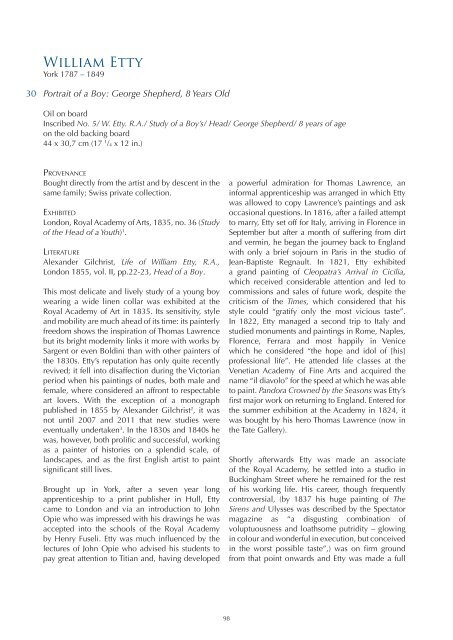XV - Works On Paper - Marty de Cambiaire (English)
You also want an ePaper? Increase the reach of your titles
YUMPU automatically turns print PDFs into web optimized ePapers that Google loves.
William Etty<br />
York 1787 – 1849<br />
30<br />
Portrait of a Boy: George Shepherd, 8 Years Old<br />
Oil on board<br />
Inscribed No. 5/ W. Etty. R.A./ Study of a Boy’s/ Head/ George Shepherd/ 8 years of age<br />
on the old backing board<br />
44 x 30,7 cm (17 1 /4 x 12 in.)<br />
PROVENANCE<br />
Bought directly from the artist and by <strong>de</strong>scent in the<br />
same family; Swiss private collection.<br />
EXHIBITED<br />
London, Royal Aca<strong>de</strong>my of Arts, 1835, no. 36 (Study<br />
of the Head of a Youth) 1 .<br />
LITERATURE<br />
Alexan<strong>de</strong>r Gilchrist, Life of William Etty, R.A.,<br />
London 1855, vol. II, pp.22-23, Head of a Boy.<br />
This most <strong>de</strong>licate and lively study of a young boy<br />
wearing a wi<strong>de</strong> linen collar was exhibited at the<br />
Royal Aca<strong>de</strong>my of Art in 1835. Its sensitivity, style<br />
and mobility are much ahead of its time: its painterly<br />
freedom shows the inspiration of Thomas Lawrence<br />
but its bright mo<strong>de</strong>rnity links it more with works by<br />
Sargent or even Boldini than with other painters of<br />
the 1830s. Etty’s reputation has only quite recently<br />
revived; it fell into disaffection during the Victorian<br />
period when his paintings of nu<strong>de</strong>s, both male and<br />
female, where consi<strong>de</strong>red an affront to respectable<br />
art lovers. With the exception of a monograph<br />
published in 1855 by Alexan<strong>de</strong>r Gilchrist 2 , it was<br />
not until 2007 and 2011 that new studies were<br />
eventually un<strong>de</strong>rtaken 3 . In the 1830s and 1840s he<br />
was, however, both prolific and successful, working<br />
as a painter of histories on a splendid scale, of<br />
landscapes, and as the first <strong>English</strong> artist to paint<br />
significant still lives.<br />
Brought up in York, after a seven year long<br />
apprenticeship to a print publisher in Hull, Etty<br />
came to London and via an introduction to John<br />
Opie who was impressed with his drawings he was<br />
accepted into the schools of the Royal Aca<strong>de</strong>my<br />
by Henry Fuseli. Etty was much influenced by the<br />
lectures of John Opie who advised his stu<strong>de</strong>nts to<br />
pay great attention to Titian and, having <strong>de</strong>veloped<br />
a powerful admiration for Thomas Lawrence, an<br />
informal apprenticeship was arranged in which Etty<br />
was allowed to copy Lawrence’s paintings and ask<br />
occasional questions. In 1816, after a failed attempt<br />
to marry, Etty set off for Italy, arriving in Florence in<br />
September but after a month of suffering from dirt<br />
and vermin, he began the journey back to England<br />
with only a brief sojourn in Paris in the studio of<br />
Jean-Baptiste Regnault. In 1821, Etty exhibited<br />
a grand painting of Cleopatra’s Arrival in Cicilia,<br />
which received consi<strong>de</strong>rable attention and led to<br />
commissions and sales of future work, <strong>de</strong>spite the<br />
criticism of the Times, which consi<strong>de</strong>red that his<br />
style could “gratify only the most vicious taste”.<br />
In 1822, Etty managed a second trip to Italy and<br />
studied monuments and paintings in Rome, Naples,<br />
Florence, Ferrara and most happily in Venice<br />
which he consi<strong>de</strong>red “the hope and idol of [his]<br />
professional life”. He atten<strong>de</strong>d life classes at the<br />
Venetian Aca<strong>de</strong>my of Fine Arts and acquired the<br />
name “il diavolo” for the speed at which he was able<br />
to paint. Pandora Crowned by the Seasons was Etty’s<br />
first major work on returning to England. Entered for<br />
the summer exhibition at the Aca<strong>de</strong>my in 1824, it<br />
was bought by his hero Thomas Lawrence (now in<br />
the Tate Gallery).<br />
Shortly afterwards Etty was ma<strong>de</strong> an associate<br />
of the Royal Aca<strong>de</strong>my, he settled into a studio in<br />
Buckingham Street where he remained for the rest<br />
of his working life. His career, though frequently<br />
controversial, (by 1837 his huge painting of The<br />
Sirens and Ulysses was <strong>de</strong>scribed by the Spectator<br />
magazine as “a disgusting combination of<br />
voluptuousness and loathsome putridity – glowing<br />
in colour and won<strong>de</strong>rful in execution, but conceived<br />
in the worst possible taste”,) was on firm ground<br />
from that point onwards and Etty was ma<strong>de</strong> a full<br />
98
















